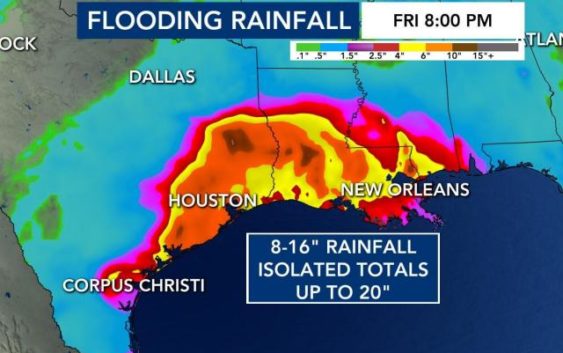- Los Angeles County wildfires latest: Pacific Palisades fire is most destructive in Los Angeles history
- Cutting-edge wildfire research shapes future building codes and safety plans
- Research institute tests wildfire defenses as California battles blazes
- Wildfires burn out of control across Los Angeles area and kill 5 as thousands flee homes
- Thousands flee as wildfires burn out of control and destroy homes across the Los Angeles area
Nicholas gets stronger, threatens to hit Texas as hurricane

HOUSTON — Tropical Storm Nicholas gathered strength Monday and threatened to blow ashore in Texas as a hurricane that could bring up to 20 inches of rain to parts of the Gulf Coast, including the same area hit by Hurricane Harvey in 2017 and storm-battered Louisiana.
Nearly all of the state’s coastline was under a tropical storm warning that included potential flash floods and urban flooding. Texas Gov. Greg Abbott said authorities placed rescue teams and resources in the Houston area and along the coast.
Forecasters at the National Hurricane Center in Miami said the system’s top sustained winds reached 60 mph (95 kph). If the winds hit 74 mph, the storm would become a Category 1 hurricane. It was moving north at 12 mph (19 kph) on a track to pass near the South Texas coast later in the day, then move onshore in the evening.
In flood-prone Houston, officials worried that heavy rain expected to arrive late Monday and early Tuesday could inundate streets and flood homes. Authorities deployed high-water rescue vehicles throughout the city and erected barricades at more than 40 locations that tend to flood, Mayor Sylvester Turner said.
“This city is very resilient. We know what we need to do. We know about preparing,” said Turner, referencing four major flood events that have hit the Houston area in recent years, including devastating damage from Harvey.
Several schools in the Houston and Galveston areas were closed Monday because of the incoming storm. The Houston school district, the state’s largest, announced that classes would be canceled on Tuesday.
COVID-19 testing and vaccination sites were closed in Harris County, which includes Houston; Fort Bend County, southwest of Houston; and Nueces County, which includes Corpus Christi.
On Monday afternoon, Nicholas was centered roughly 70 miles (113 kilometers) southeast of Port Aransas, Texas, and 105 miles (169 kilometers) south of Port O’Connor, Texas. It was “moving erratically” just offshore, the hurricane center said.
A hurricane watch was issued from Port Aransas to San Luis Pass.
Eight to 16 inches (20 to 40 centimeters) of rain were expected along the middle and upper Texas coast, with isolated maximum amounts of 20 inches (50 centimeters) possible. Other parts of southeast Texas and southwest Louisiana could see 5 to 10 inches (12.5 to 25 centimeters) over the coming days.
“Listen to local weather alerts and heed local advisories about the right and safe thing to do, and you’ll make it through this storm just like you’ve had many other storms,” Abbott said during a news conference in Houston.
Nicholas was headed toward the same area of Texas that was hit hard by Harvey. That storm made landfall in the middle Texas coast then stalled for four days, dropping more than 60 inches (152 cm) of rain in parts of southeast Texas. Harvey was blamed for at least 68 deaths, including 36 in the Houston area.
But University of Miami hurricane researcher Brian McNoldy said he expects that Nicholas “will be magnitudes less than Harvey in every regard.”
The worry with Nicholas will be how slowly it moves. Storms are moving slower in recent decades, and Nicholas could get stuck between two other weather systems, said hurricane researcher Jim Kossin of The Climate Service.
Louisiana Gov. John Bel Edwards declared a state of emergency Sunday night, ahead of the storm’s arrival in a state still recovering from Hurricane Ida and last year’s Hurricane Laura and historic flooding.
“The most severe threat to Louisiana is in the southwest portion of the state, where recovery from Hurricane Laura and the May flooding is ongoing,” Edwards said.
The storm was expected to bring the heaviest rainfall west of where Ida slammed into Louisiana two weeks ago.
Across Louisiana, almost 120,000 customers remained without power Monday morning, according to the utility tracking site poweroutage.us.
While Lake Charles received minimal impact from Ida, the city saw multiple wallops from Hurricane Laura and Hurricane Delta in 2020, a winter storm in February as well as historic flooding this spring.
Lake Charles Mayor Nic Hunter said the city is taking the threat of the storm seriously, as it does all tropical systems.
“Hope and prayer is not a good game plan,” Hunter said.
In Cameron Parish in coastal Louisiana, Scott Trahan was still finishing repairs on his home from Hurricane Laura, which put about 2 feet of water in his house. He hopes to be finished by Christmas. He said many in his area have moved instead of rebuilding.
“If you get your butt whipped about four times, you are not going to get back up again. You are going to go somewhere else,” Trahan said.
Colorado State University hurricane researcher Phil Klotzbach said via Twitter that Nicholas is the 14th named storm of the 2021 Atlantic hurricane season. Only four other years since 1966 have had 14 or more named storms by Sept. 12: 2005, 2011, 2012 and 2020.
___
Associated Press Writer Jill Bleed in Little Rock, Arkansas, and AP Science Writer Seth Borenstein in Washington contributed to this report.
___
Follow Juan A. Lozano on Twitter: https://twitter.com/juanlozano70